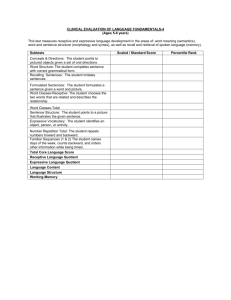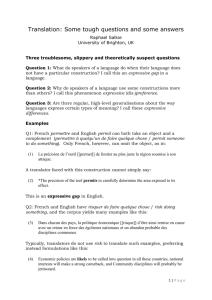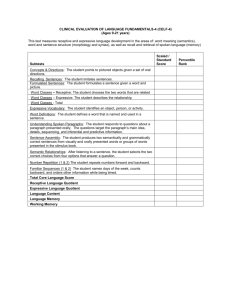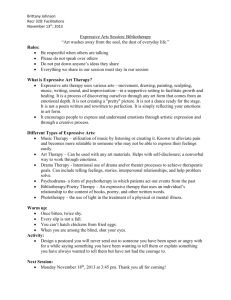The Efficacy of Expressive Arts Therapy in the Creation of... Mediterranean Journal of Social Sciences Sh Marzety Adibah, A.S.M MCSER Publishing, Rome-Italy
advertisement
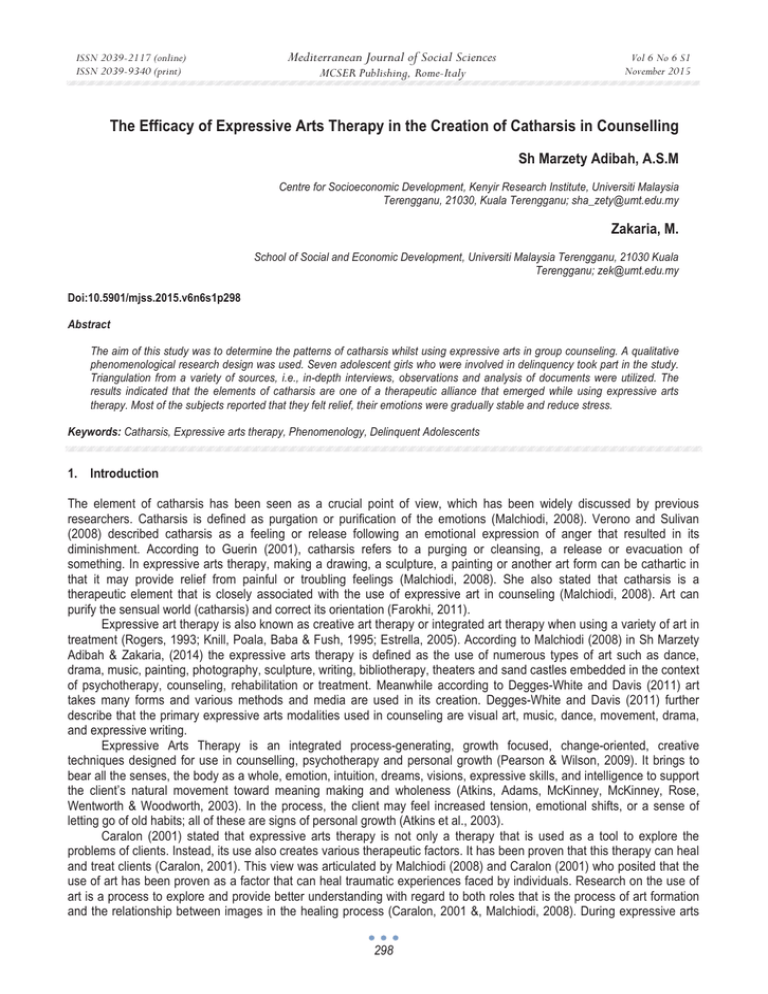
ISSN 2039-2117 (online) ISSN 2039-9340 (print) Mediterranean Journal of Social Sciences MCSER Publishing, Rome-Italy Vol 6 No 6 S1 November 2015 The Efficacy of Expressive Arts Therapy in the Creation of Catharsis in Counselling Sh Marzety Adibah, A.S.M Centre for Socioeconomic Development, Kenyir Research Institute, Universiti Malaysia Terengganu, 21030, Kuala Terengganu; sha_zety@umt.edu.my Zakaria, M. School of Social and Economic Development, Universiti Malaysia Terengganu, 21030 Kuala Terengganu; zek@umt.edu.my Doi:10.5901/mjss.2015.v6n6s1p298 Abstract The aim of this study was to determine the patterns of catharsis whilst using expressive arts in group counseling. A qualitative phenomenological research design was used. Seven adolescent girls who were involved in delinquency took part in the study. Triangulation from a variety of sources, i.e., in-depth interviews, observations and analysis of documents were utilized. The results indicated that the elements of catharsis are one of a therapeutic alliance that emerged while using expressive arts therapy. Most of the subjects reported that they felt relief, their emotions were gradually stable and reduce stress. Keywords: Catharsis, Expressive arts therapy, Phenomenology, Delinquent Adolescents 1. Introduction The element of catharsis has been seen as a crucial point of view, which has been widely discussed by previous researchers. Catharsis is defined as purgation or purification of the emotions (Malchiodi, 2008). Verono and Sulivan (2008) described catharsis as a feeling or release following an emotional expression of anger that resulted in its diminishment. According to Guerin (2001), catharsis refers to a purging or cleansing, a release or evacuation of something. In expressive arts therapy, making a drawing, a sculpture, a painting or another art form can be cathartic in that it may provide relief from painful or troubling feelings (Malchiodi, 2008). She also stated that catharsis is a therapeutic element that is closely associated with the use of expressive art in counseling (Malchiodi, 2008). Art can purify the sensual world (catharsis) and correct its orientation (Farokhi, 2011). Expressive art therapy is also known as creative art therapy or integrated art therapy when using a variety of art in treatment (Rogers, 1993; Knill, Poala, Baba & Fush, 1995; Estrella, 2005). According to Malchiodi (2008) in Sh Marzety Adibah & Zakaria, (2014) the expressive arts therapy is defined as the use of numerous types of art such as dance, drama, music, painting, photography, sculpture, writing, bibliotherapy, theaters and sand castles embedded in the context of psychotherapy, counseling, rehabilitation or treatment. Meanwhile according to Degges-White and Davis (2011) art takes many forms and various methods and media are used in its creation. Degges-White and Davis (2011) further describe that the primary expressive arts modalities used in counseling are visual art, music, dance, movement, drama, and expressive writing. Expressive Arts Therapy is an integrated process-generating, growth focused, change-oriented, creative techniques designed for use in counselling, psychotherapy and personal growth (Pearson & Wilson, 2009). It brings to bear all the senses, the body as a whole, emotion, intuition, dreams, visions, expressive skills, and intelligence to support the client’s natural movement toward meaning making and wholeness (Atkins, Adams, McKinney, McKinney, Rose, Wentworth & Woodworth, 2003). In the process, the client may feel increased tension, emotional shifts, or a sense of letting go of old habits; all of these are signs of personal growth (Atkins et al., 2003). Caralon (2001) stated that expressive arts therapy is not only a therapy that is used as a tool to explore the problems of clients. Instead, its use also creates various therapeutic factors. It has been proven that this therapy can heal and treat clients (Caralon, 2001). This view was articulated by Malchiodi (2008) and Caralon (2001) who posited that the use of art has been proven as a factor that can heal traumatic experiences faced by individuals. Research on the use of art is a process to explore and provide better understanding with regard to both roles that is the process of art formation and the relationship between images in the healing process (Caralon, 2001 &, Malchiodi, 2008). During expressive arts 298 ISSN 2039-2117 (online) ISSN 2039-9340 (print) Mediterranean Journal of Social Sciences MCSER Publishing, Rome-Italy Vol 6 No 6 S1 November 2015 therapy counseling sessions, therapists can provide clients a wide range of modalities available to provide the best support for the healing of clients’ emotions. Through the use of symbols and icons of various types of media, children and adolescents can re-experience or re-create the events that have happened in their lives in an easier way (Camilleri, 2007). The use of a variety of art media in expressive arts therapy is a combination of approaches that can be implemented in many different settings (Riley, 1999). Expressive arts therapy can be implemented to children, youth, adults or the elderly. For children and adolescents, expressive arts therapy is a way to create, express and state their experiences and feelings non-verbally. This is also very important to adolescents as art allows artistic self-expression towards their cognitive, developmental and emotional level (Graham & Sontag, 2001), and it is also a form of communication that helps adolescents to avoid the possibility of harbouring their ill feelings or expressing any inherent feelings in such a damaging manner (Saunders & Saunders, 2000). Expression through the arts is helpful in relieving emotions (Malchiodi, 2005). Therapeutic Creative Arts Therapy experiences often provide opportunities to indulge catharsis due to emotions or relationships that are difficult to be described through experience and re-expression in a form which is easier to be handled or explained (Camilleri,2007). Previous researchers have also indicated that interventions based on using art are very effective in treating children and adolescents who experience stress and trauma. According to Appleton (2001), the use of creative art in counseling provides an avenue for images of traumatic and painful memories to ameliorate the symptoms of psychological stress of an individual. Carr (2005) discussed the use of art as a component in a comprehensive programmed with individuals who underwent traumatic brain disorder. He also proposed the introduction of art as an element to maintain creative recreation or activity during leisure to improve the quality of life of a person who has experienced traumatic brain disorder. Many studies have been conducted to test the effectiveness of expressive arts therapy in lowering stress levels, stabilizing emotions, healing to the clients and emotional expression (Hanes, 2000; Hartz & Thick, 2005; Puig, Lee, Goodwin & Sherrard, 2006; Sh Marzety Adibah, Zakaria, Baharuddin & Rabaaton Adawiyah, 2013; Kim & Ki, 2014). A study conducted by Wikstrom (2005) aimed to investigate what happens when children in the hospital are given the opportunity to be treated by using expressive arts therapy such as clay, paint and textiles as mediums. The results of this study show expressive arts therapy is very helpful for children to proclaim or express their pain and feelings of confinement at the hospital. A study conducted on drug addicts by Sh Marzety Adibah et al. (2013) suggests several themes that emerged after the expressive arts therapy sessions, which are, giving meaning, healing, awareness, selfconfidence and even catharsis. The expression of creativity via various media is crucial in helping the clients to come out from the shackles or fetters of their life especially adolescents or clients who have faced extreme trauma. Its use can help a client to release unconscious stress expressed through particular images and symbols to recreate disturbed thoughts and images. Its use can also produce whatever feelings that have been suppressed or subdued in the person. This study aims to understand the patterns of catharsis whilst using expressive arts therapy in group counseling. 2. Methodology 2.1 Design This study is based on a qualitative research which used phenomenological approach to understand the pattern of catharsis in life experience of delinquent adolescents. According to Moustakas (1994) and Patton (2002), phenomenology refers to the perspectives of philosophy and the methodology that try to translate the essence of a phenomenon that forms knowledge conscious experience. This approach is a study on the essence, a picture of phenomenon (MerleauPonty, 1962) that is what is created in the mind such as a physical object, thought and emotion (Ehrich, 2003). Generally, this study focuses on the inner process and interaction with the phenomenon of delinquent behavior faced by subjects. It also gives emphasis on the interaction with their experiences using expressive arts therapy to state a reality, believe that knowledge is formed from within, explore and maintain individual perspective under study. Specifically, this study attempts to have an insight as to how life experiences of delinquent adolescents interact with their experiences after having undergone group counseling sessions that uses expressive arts therapy in the process to create meaning. 2.2 Participants The purposeful samplings method was used to select the participants of this study. In this sampling, the researchers 299 ISSN 2039-2117 (online) ISSN 2039-9340 (print) Mediterranean Journal of Social Sciences MCSER Publishing, Rome-Italy Vol 6 No 6 S1 November 2015 decided on the individuals and places based on the scrutiny and the purpose of the study to find people who can and were willing to provide the information by virtue of their knowledge and experience. Seven of delinquent adolescent girls between ages 16-18 years participated in the study. The participants were chosen among those who experience delinquent. 2.3 Procedure The participants in this study went through a total of 8 expressive arts therapy group counseling. Several expressive arts therapy techniques were used and implemented in this group. Counselling sessions namely the techniques of Collage Name, Map of Life Sketches, Extreme Negative Feelings and Thinking, Butterfly Story, Wave Painting and Expressive Writing Using Diary were used. Each expressive arts therapy group session was run for 90 minutes. A summary of the therapy sessions is shown below. 2.3.1 Session 1: Collage Name The technique used in the first session was Collage Name. Collage Name technique was used to facilitate the participants in introducing themselves and generating warmth, in other words an ice breaking session. In this technique, participants were asked to produce a name or photo collage representing them. 2.3.2 Session 2 and Session 3: Sketch Map of Life In the second and third sessions, the researchers used the Sketch Map of Life technique. Participants in this study were asked to imagine a map and journey that each and every member was experiencing in their lives at the moment and previously. Next they were asked to draw the map and journey. 2.3.3 Session 4: Extreme Negative Feelings and Thoughts Extreme Negative Feelings and Thoughts technique was applied in the fourth session in which participants were asked to produce an artistic creation that represents positive and negative feelings within themselves. 2.3.4 Session 5 and Session 6: Butterfly Stories These sessions were for participants to relate the hardships, challenges and obstacles they have had with the analogy of a butterfly. Researchers used the Butterfly Stories technique in this session. In this session, the counselor brought the story of a butterfly for members in the group. Stories of the butterfly’s life and the metamorphosis were discussed and described to relate and reveal the perseverance of a butterfly that has been fighting for its life which is full of challenges, obstacles and dangers. 2.3.5 Session 7: Waves Painting During the seventh session, the researchers used the technique of Waves Painting. In this session, participants were asked to sketch drawings of waves according to their creativity. Before sketching, the participants were at first asked to listen to music of waves and the researchers asked participants to appreciate and feel the serenity in the music. 2.3.6 Session 8: Reflection & Expressive Writing This session was a time where the researchers together with the research participants did reflection on the whole session. Participants were asked to share their experiences, demonstrate, exhibit and present all artworks and includes their diary writing. 2.4 Data Collection In depth interviews, observation, and document analysis were used to collect data in this study. The interviews in this study were structured using three interview method technique by Seidman (2006). Seidman (1998) further expressed that 300 ISSN 2039-2117 (online) ISSN 2039-9340 (print) Mediterranean Journal of Social Sciences MCSER Publishing, Rome-Italy Vol 6 No 6 S1 November 2015 the mystery of the participants’ experience can be understood and the experience can be placed into context by the interviewer after these three interviews are compiled. The flows of these interview series are; firstly; the context for the experiences of the participants is provided. Secondly; the participants are allowed to reconstruct the details of their experiences regarding the phenomenon being studied and lastly the participants are encouraged to recall the meaning and essence of their experiences (Seidman, 1998). Verbal and non-verbal observations of each and every participant during counseling sessions in using expressive arts therapy were done via the butterfly story, life mapping, waves drawing, collage name and expressive writing. According to Silverman (2002), actual situations of the phenomenon under study can be obtained through observation of the participant. The participant’s reactions, dialogue, and movement are observed in each group counselling sessions. During the counseling session, the researchers made field notes for each participant was observed in each group session. The third source was analysis of documents. The participants were required to write a diary which expressed their experiences while using expressive arts therapy. Participants were asked to describe experiences from their past as well as their feeling and response to the group counseling sessions. 2.5 Validity and Reliability The validity and reliability of the research results were tested through various approaches, which are; process of data triangulation, prolonged engagement, peer review and audit trail. Guion (2002) identifies five types of triangulation i.e. data triangulation, investigator triangulation, theory triangulation, methodological triangulation and environmental triangulation. In this study, data triangulation was adopted through multiple sources of data collection. Data triangulation may involve the use of different sources of data, information or methods (Guion; 2002; Shenton; 2004) especially observation, focus groups and individual interviews (Shenton, 2004). Therefore, the three interviews and observation from eight group counseling sessions and analysis of diary from each participant were the multiple sources that were adopted in this study. Thus, the results’ validity and reliability were confirmed as these various sources of data were collected during the course of the study. As regard to prolonged engagement, this study was conducted for six months. Thus, the researcher had spent extensive time with the participants to increase the rapport where ultimately the participants became more open to communicate and interact with the researcher (Li, 2004). Spending more time with the participants enhances the ability of the researcher of this qualitative research to reach saturation of the data (Lietz, Langer & Furman, 2006) as they can see the patterns in the data which help the researchers to understand the studied phenomenon better (Patton, 2002). Another method to validate the research findings was peer review. Li (2004) expressed that researchers should regularly seek out and interact with other professionals engaged in similar work. This peer review referred to allowing peer comments regarding the data in this study. In this study, as soon as collection of data was carried out, discussions, reviews by peers were always conducted. Lastly, the research was validated by an audit trail. The audit trail is a way in which each of the steps taken during the research process were documented (Othman Lebar, 2006). Everything related to the research process from beginning to the end was documented in detail. All the results and data findings were cited with their sources by writing their index and numbers to be validated. 2.6 Data Analysis Giorgi’s recommendations (Giorgi & Giorgi, 2003) were followed when analyzing the data in this research. The process begins with reading the transcript several times to find the whole meaning. Through this step, the life experiences of the particular youth and their experiences during group counseling sessions using expressive arts therapy was understood. Reading this holistically helped the researchers to be prepared for the next step. The second step based on this procedure, was discrimination of meaning units where verbatim and transcripts of the interview were separated into more meaningful and understandable units as the text cannot be interpreted overall. The third step was the early transfer of meaning units where the meaning that appeared in every meaning unit in a language that was parallel and almost identical to the language used by the research participants were highlighted. Then, the experiences of the participants regarding their lives were changed into a language that contained psychological meaning. The researcher tried to imagine all the possible variations and interpretations that could be garnered in a particular section to ascertain the main aspect that should be added to represent the experiences of the participant holistically. 301 ISSN 2039-2117 (online) ISSN 2039-9340 (print) Mediterranean Journal of Social Sciences Vol 6 No 6 S1 November 2015 MCSER Publishing, Rome-Italy Further step was to define each individual’s psychological structure where all the meaning units found in a particular transcript of the individual were combined into a comprehensive and complete description which described the experiences of the individual. The final step was to determine the general psychological structure where in this study, the researchers tried to move from the experiences of the individual with regards to their lives into a general description about these experiences for all the adolescents involved. At this juncture, the theme of the study emerged successfully. 3. Results Most of the research participants experienced various psychological issues which caused them to face traumatic and extreme emotional disturbances. Nevertheless, in the end they underwent various changes and a catharsis which was a result of their experiences undergoing counseling sessions involving and using this expressive arts therapy. They mentioned that the use of creativity and art enabled them to reduce stress, stabilize emotions and provide release from the emotional disturbances that was a part of their life. Pseudo names were given to all the participants to protect their identity. The themes are listed in Table 1 and Participant artwork can be seen in figure 1. Table 1: Themes THEME Reduction of stress Khaty ¥ ¥ ¥ ¥ ¥ ¥ ¥ ¥ ¥ ¥ Stabilization of emotion Relief 3.1 PARTICIPANT Zaza Lily Kamelia Salma ¥ ¥ ¥ Fifi Rina ¥ ¥ ¥ ¥ ¥ ¥ Reduction of stress Six out of seven participants professed that the use of art and creativity in group counseling sessions enabled and helped them to reduce the stress that they faced. Expressive art is an approach that can treat participants as mentioned by participant Salma. Sessions using art and creativity provided healing and reduction of stress and the burden that had long been shouldered by Salma. Salma stated that all her burdens were removed via her expression in the painting of waves, drawing and the emergence of objects that were produced. Khaty shared that her life was no longer shackled by stressful feelings as before. A state of calm began to surface in her life. Every pain and difficulty was completely expressed. Salma said; “Lately, the stress that I have been experiencing has started to gradually subside” Similar feelings were shared by Zaza, Lily, Kamelia and Rina. They expressed that the techniques and approaches used in this therapy reduced stressful feelings endured by them all this while. Painting waves technique in Figure 2 imbued and injected enough confidence so that they were able to make changes in their future. All extreme feelings which were prevalent in them before this were expressed and stated completely without any coercion. Those expressions were able to reduce the stress, emotional disturbances and trauma and were replaced by peace and calm. Kamelia stated; “Expressive arts therapy sessions that I've been through, can reduce the stress and pressure within me. Now I can handle the pressure and stress in my life in peace without messing up my head.” Zaza: “I can express my feelings which up till now have been excluded, therefore it can eliminate the burden that I bore all along.” Fifi: “Yes, through this program, the stress is gone and I have experienced less pressure as compared to prior to this....I no longer have headaches.” 302 ISSN 2039-2117 (online) ISSN 2039-9340 (print) 3.2 Mediterranean Journal of Social Sciences MCSER Publishing, Rome-Italy Vol 6 No 6 S1 November 2015 Stabilization of emotion Most of the research participants stated that using art activities in group counseling was a technique that was able to stabilize their emotions. Figure 3 illustrated the art activities using Extreme Negative Feeling and Thought. Khaty said that she had discarded all negative feelings. She also said that all detest and resentment within her were reduced. She also felt that she was able to forgive her father. Her emotions also stabilized on realization that the feelings within her were similar to tidal waves in her drawings and painting. Khaty expressed; “After going through Expressive arts therapy, my negative feelings have been cured, compared to before.” “I also have managed to control my feelings which were quick to being emotional and sensitive before this.” Zaza also confessed that her emotions had improved and were stable since attending expressive arts therapy sessions. She had discarded all her emotions of revenge, anger and detest towards her mother when drawing the rolling of waves during the sessions. The emotional stability felt by Lily made her believe that she was able to face any form of challenge that may come her way in the future. Lily said; “I am a hot-tempered person but after I joined this Expressive arts therapy, I feel that the anger in me has started to vanish little by little.” Kamelia professed similar feelings. She spoke about her emotions which were more stable and that she was currently experiencing peace and calm in her life. Kamelia expressed; “This expressive arts therapy session has cured the negatives feelings in me such as anger, sadness, rebelliousness, envy and others.” Fifi admitted that she was able to eliminate a feeling of hatred towards her adoptive mother through the sessions of drawing waves. Every negative feeling within her was removed and this made Fifi feel peace and to be at ease when her emotions were under control. Rina also shared and related that her emotions were more stable. Prior to this, Rina articulated that she was unable to control her emotions. Nevertheless through her experiences during expressive art sessions, she was able to change everything. Rina said; “The expressive arts therapy that I have followed has reduced my emotions and stress. I won’t shout at anyone. I will be patient only.” “I also can control my negative feelings in my heart before this. For example: stress, feeling of revenge, being emotional, shouting, scolding, controlling others, and not understanding anyone. But now I can control all my negative feelings and I also learn to be positive in my outlook” 3.3 Relief All the research participants expressed that they felt relief as a result of using this expressive arts therapy. Figure 4 illustrate their expressions of feelings and sharing via drawing butterfly, writing the objects and specific symbols that they created themselves provided an in depth creative relationship resulting in providing relief. Salma, Khaty, Zaza, Lily, Kamelia, Fifi and Rina related their experiences which provided them with relief through their complete involvement in this therapy. Khaty professed; “I think I am more tolerant and at peace now after I could express what have been hidden and pent-up in my heart.” Rina: “Before I joined this expressive arts therapy, I kept a lot of feelings in my heart. After I joined and I did the activities, I can control my feelings, and just let the negative thoughts go. I’m very thankful to this form of counseling because it has helped me in a lot of ways.” Fifi; “This therapy has cured the feelings that I used to experience before which were filled with problems related to family, 303 ISSN 2039-2117 (online) ISSN 2039-9340 (print) Mediterranean Journal of Social Sciences MCSER Publishing, Rome-Italy Vol 6 No 6 S1 November 2015 friends, teachers, frustrations, sadness, lack of love and happiness.” Zaza; “I think that by expressing my feelings, it makes me feel relieved.” Kamelia: “After joining this counseling session, I feel a sense of relief and some of my burden is lifted. I was like a cocoon but is now free from imprisonment.” 304 ISSN 2039-2117 (online) ISSN 2039-9340 (print) Mediterranean Journal of Social Sciences MCSER Publishing, Rome-Italy Vol 6 No 6 S1 November 2015 Figure 1: Participant Artworks 4. Conclusion As a conclusion, the experiences shared by the adolescent involved in juvenile delinquency as participants, there was a profound effect after undergoing sessions using expressive arts therapy. The participants unhesitatingly expressed the benefits obtained in those sessions. Most of them shared that there was a marked reduction of stress level as compared to what they experienced before. The implementation of expressive arts therapy in group counseling had reduced and stabilized their emotions through the expressions of their feelings. This study showed that the participants had gained new meaning towards interpreting the pain that they endured all this while. Expressive arts therapy stimulated them to express their thoughts, emotions, ideas or beliefs through the senses. They felt deep relief and explored the conflicts of life through the symbolic and metaphoric pictures. All those feelings showed that they had experienced a catharsis. The physical and inner recovery required a combination of psychosomatic and psychiatric aspects. These combined aspects were able to trigger self-acceptance and change. This therapy changed a negative psychosomatic picture that was present in the mind of the research participant into a creative and positive artistic experience. They were able to present their art as a special and meaningful metaphor. The essence of the meaning obtained was translated into a catharsis. The catharsis achieved gave meaning to the participants that stabilized their emotions and reduced stress. The themes that emerged in this study this showed that the use of expressive arts therapy is a technique or way which can be applied by counselors to help individuals who are in crisis and various psychological issues to achieve catharsis. This therapy is a technique that is quite relaxing to be implemented and it can make the research participants emotional expressions from deep within them. The used of expressive arts therapy in bringing re-awakening of past traumatic experiences, is not only restricted to children and adolescents but can also be effectively used for adults. Expressive arts therapy can help the counselors to identify and guide clients to get out of the shackles and uncover their history and bring a new hope for them to continue their life. The implication of this study can be used as a highly effective module by counselors in exploring the client's life experience, especially adolescents in addressing social ills which are increasingly spreading among the society these days. Furthermore, the counsellor who is seeking for a technique or an alternative method than traditional counselling can use the results or findings from this study as one of the methods that can benefits counselling sessions. Further studies to assess the effectiveness of the expressive art therapy toward specific problems also may be done in future. References Appleton, V. (2001). Avenue of hope: Art therapy and the resolution of trauma. Art Therapy: Journal of the American Art Therapy Association, 18(3), 50-55. Atkins, S., Adams, M., McKinney, C., McKinney, H., Rose, L., Wentworth, J. & Woodworth, J. (2003). Expressive arts therapy: Creative process in art and life. Boone, North Carolina: Parlway Publishers. Carolan, R. (2001). Models and paradigms of art therapy research. Art Therapy: Journal of the American Art Therapy Association, 18(4), 190-206. Carr, G. (2005). Improving quality of life for persons with traumatic brain injury: The role of therapeutic recreation. In C. L. Navenec& L. 305 ISSN 2039-2117 (online) ISSN 2039-9340 (print) Mediterranean Journal of Social Sciences MCSER Publishing, Rome-Italy Vol 6 No 6 S1 November 2015 Bridges (Eds.), Creating connections between nursing care and the creative arts therapies (pp.106-115). Springfield, IL: Charles C. Thomas. Camilleri V.A., (2007). Healing the Inner City Child Creative Arts Therapies with At-risk Youth. Jessica Kingsley Publishers: London and Philadelphia. Degges-White and Davis. (2011). Integrating the Expressive Arts into Counseling Practice: Theory-Based Interventions. New York: Springer Publishing Company. Ehrich, L. C. (2003). Phenomenology: The quest for meaning. In T. A. O’Donoghue & K. Punch (Eds.), Qualitative educational research in action: Doing and reflecting (pp. 42-69). New York, NY: Routledge Falmer. Estrella, K. (2005). Expressive therapy: An integrated approach. In C. Malchiodi, C.A (Ed.), Expressive therapies (pp. 183-209). New York, NY: The Guilford Press. Farokhi, M. (2011). Art therapy in humanistic psychiatry. Social and Behavioral Sciences, 30, 2088-2092. Giorgi, A., & Giorgi, B. (2003).Phenomenology. In J. A. Smith, Qualitative psychology: A practical guide to research methods (pp. 25-50). London, UK: Sage. Graham, M., & Sontag, M. (2001). Art as an evaluative tool: A pilot study. Art Therapy: Journal of the American Art Therapy Association, 18(1), 37-43. Guerin, B. (2001). Replacing catharsis and uncertainty reduction theories with descriptions of historical and social context. Review of General Psychology, 5(1), 44-61 Guion, L.A. (2002). Triangulation: Establishing the validity of qualitative studies. University of Florida, The Institute of Food and Agricultural Science. Hanes, M. (2000).Catharsis in art therapy: A case study of a sexually abused adolescent. Art Therapy: Journal of the American Art Therapy Association,38(3), 70-74. Hartz, L., & Thick, L. (2005). Art therapy strategies to raise self-esteem in female juvenile offenders: A comparison of art psychotherapy and art as therapy approaches. Art Therapy: Journal of the American Art Therapy Association, 22(2), 70-80. Kim, S., & Ki, J. (2014). A case study on the effects of the creative art therapy with stretching and walking meditation—Focusing on the improvement of emotional expression and alleviation of somatisation symptoms in a neurasthenic adolescent. The Arts in Psychotherapy, 41(1), 71-78. Knill, P. J., Baba, H. N., & Fuchs, M. N. (1995). Minstrels of the soul: Intermodal expressive therapy. Toronto, Canada: Palmerston Press. Li, D. (2004). Trustworthiness of think-aloud protocols in the study of translation processes. International Journal of Applied Linguistics, 14 (3). Lietz, C.A., Langer, C.L. & Furman, R. (2006). Establishing trustworthiness in qualitative research in social work: Implications from a study regarding spirituality. Qualitative Social Work, 5(4), 441-458. Malchiodi, C. (2005). Expressive Therapies. New York: The Guilford Press Malchiodi, C. A. (2008). Creative interventions with traumatized children. New York, NY: The Guilford Press. Malchiodi (2008) in Sh Marzety Adibah, A.S.M, & Zakaria, M., (2014). The Use of Expressive Arts Therapy in Understanding Psychological Issues of Juvenile Delinquency. Asian Social Science, 10(9), p144. Merleau-Ponty, M. (1962). The phenomenology of perception. London, UK: Routledge. Moustakas, C., (1994). Phenomenological research methods. Thousand Oaks, CA: Sage. Othman Lebar. (2006). Penyelidikan kualitatif: Pengenalan teori dan metod. Tanjung Malim, Malaysia: Penerbit Universiti Pendidikan Sultan Idris Patton, M. Q. (2002). Qualitative research & evaluation methods. Thousand Oaks, CA: Sage. Pearson, M., & Wilson, H. (2009). Using expressive arts to work with mind, body and emotions. Theory and practice. London: Jessica Kingsley Publishers. Puig, A., Lee, S.M., Goodwin, L., & Sherrard, G., (2006). The efficacy of creative arts therapies to enhance emotional expression, spirituality, and psychological well-being of newly diagnosed Stage I and Stage II breast cancer patients: A preliminary study. The Arts in Psychotherapy 33(3), 218–228. Riley, S. (1999). Illustrating the family story: Art therapy a lens for viewing the family’s reality. Art in Psychotherapy, 20(3), 254-264. Rogers, N. (1993). The creative connection: Expressive arts as healing. Palo Alto, CA: Science and Behavior Books. Saunders, E., & Saunders, J. A. (2000). Evaluating the effectiveness of art therapy through a quantitative, outcomes-focused study. Arts in Psychotherapy, 27(2), 99-106. Seidman, E. (1998). Interviewing as qualitative research. New York, NY: Columbia University Press. Shenton, A.K. (2004). Strategies for ensuring trustworthiness in qualitative research projects. Education for Information, 22(2), 63-75. Sh Marzety Adibah, A.S.M, Zakaria, M., Baharuddin, I. & Rabaaton Adawiyah, Y. (2013). Therapeutic Experience of Drug Rehabilitation Clients through Expressive Arts Therapy. International Journal of Humanities and Social Science 3(17), 210-223 Silverman, D. (2002). Doing qualitative research: A practical handbook. London, UK: Sage. Verono, E., & Sulivan. A. E. (2008). Emotional catharsis and aggression revisited: heart rate reduction following aggressive responding. American Psychological Association, 8(3), 331-340. Wikstrom, B. M. (2004). Communicating via expressive arts: the natural medium of self- expression for hospitalized children. Pediatric nursing, 31(6), 480-485. 306
